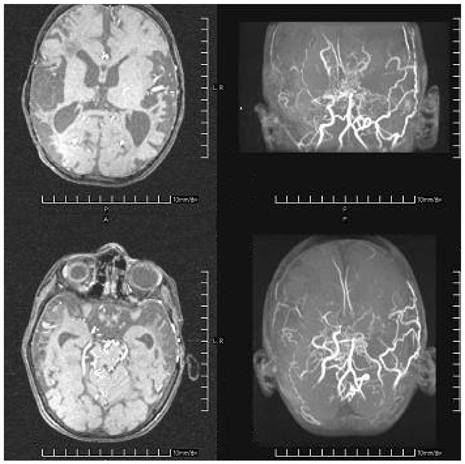J Clin Neurol.
2012 Jun;8(2):100-103.
Clinical Features, Prothrombotic Risk Factors, and Long-Term Follow-Up of Eight Pediatric Moyamoya Patients
- Affiliations
-
- 1Department of Pediatric Neurology, Istanbul Medical Faculty, Istanbul, Turkey. ekicibaris@yahoo.com
- 2Department of Neurosurgery, Istanbul Medical Faculty, Istanbul, Turkey.
- 3Department of Radiodiagnostics, Istanbul Medical Faculty, Istanbul, Turkey.
Abstract
- BACKGROUND AND PURPOSE
The aim of this study was to elucidate the clinical features, prothrombotic risk factors, and outcome of pediatric Moyamoya patients.
METHODS
Patients diagnosed with Moyamoya disease at a tertiary center between January 2000 and December 2006 were enrolled in this study. The clinical presentations, underlying diseases, prothrombotic risk factors, family history of thrombosis, radiological findings, treatment, and outcome of the patients were reviewed retrospectively.
RESULTS
Eight patients with angiographically proven Moyamoya disease were identified, one of whom had neurofibromatosis type I and one had Down syndrome. The age at diagnosis varied between 19 months and 11 years (73.4+/-41.8 months, mean+/-SD). The follow-up period after diagnosis was 52.5+/-14.8 months. In six patients, the initial clinical presentation was hemiparesis. None of the patients had any identifiable prothrombotic factors. Despite medical and surgical treatment, three patients had recurrences and one died. Only two patients recovered without sequelae.
CONCLUSIONS
The value of prothrombotic risk factor evaluation appears to be limited in Moyamoya patients; the outcome for pediatric patients remains dismal.
MeSH Terms
Figure
Reference
-
1. Gosalakkal JA. Moyamoya disease: a review. Neurol India. 2002. 50:6–10.2. Ikezaki K, Han DH, Kawano T, Kinukawa N, Fukui M. A clinical comparison of definite moyamoya disease between South Korea and Japan. Stroke. 1997. 28:2513–2517.
Article3. Shetty-Alva N, Alva S. Familial moyamoya disease in Caucasians. Pediatr Neurol. 2000. 23:445–447.
Article4. Scott RM, Smith ER. Moyamoya disease and moyamoya syndrome. N Engl J Med. 2009. 360:1226–1237.
Article5. deVeber G, Monagle P, Chan A, MacGregor D, Curtis R, Lee S, et al. Prothrombotic disorders in infants and children with cerebral thromboembolism. Arch Neurol. 1998. 55:1539–1543.
Article6. Bonduel M, Hepner M, Sciuccati G, Torres AF, Tenembaum S. Prothrombotic disorders in children with moyamoya syndrome. Stroke. 2001. 32:1786–1792.
Article7. Akgün D, YiLmaz S, Senbil N, Aslan B, Gürer YY. Moyamoya syndrome with protein S deficiency. Eur J Paediatr Neurol. 2000. 4:185–188.
Article8. Cheong PL, Lee WT, Liu HM, Lin KH. Moyamoya syndrome with inherited proteins C and S deficiency: report of one case. Acta Paediatr Taiwan. 2005. 46:31–34.9. Lutterman J, Scott M, Nass R, Geva T. Moyamoya syndrome associated with congenital heart disease. Pediatrics. 1998. 101:57–60.
Article10. Jea A, Smith ER, Robertson R, Scott RM. Moyamoya syndrome associated with Down syndrome: outcome after surgical revascularization. Pediatrics. 2005. 116:e694–e701.
Article11. Hogan AM, Kirkham FJ, Isaacs EB, Wade AM, Vargha-Khadem F. Intellectual decline in children with moyamoya and sickle cell anaemia. Dev Med Child Neurol. 2005. 47:824–829.
Article12. Scott RM. Surgery for moyamoya syndrome? Yes. Arch Neurol. 2001. 58:128–129.13. Golby AJ, Marks MP, Thompson RC, Steinberg GK. Direct and combined revascularization in pediatric moyamoya disease. Neurosurgery. 1999. 45:50–58.
Article14. Khan N, Schuknecht B, Boltshauser E, Capone A, Buck A, Imhof HG, et al. Moyamoya disease and Moyamoya syndrome: experience in Europe; choice of revascularisation procedures. Acta Neurochir (Wien). 2003. 145:1061–1071.
Article15. Lanthier S, Carmant L, David M, Larbrisseau A, de Veber G. Stroke in children: the coexistence of multiple risk factors predicts poor outcome. Neurology. 2000. 54:371–378.
Article
- Full Text Links
- Actions
-
Cited
- CITED
-
- Close
- Share
- Similar articles
-
- Neonatal Thromboembolic Disorders
- Moyamoya Syndrome Precipitated by Cranial Irradiation for Craniopharyngioma in Children
- Long-Term Follow-up Study after Superficial Temporal Artery-Middle Cerebral Artery Anastomosis plus Encephalomyosynangiosis for Moyamoya Disease
- Moyamoya Disease in Children and Adolescents
- Long Term Magnetic Resonance Angiography Follow-up in Moyamoya Disease





